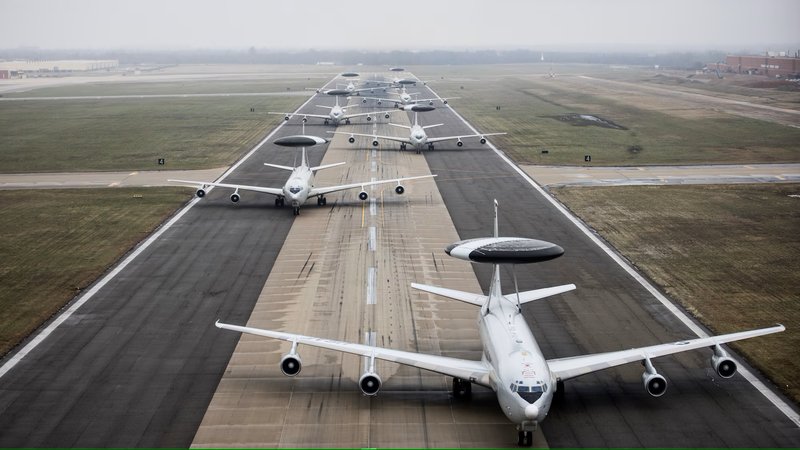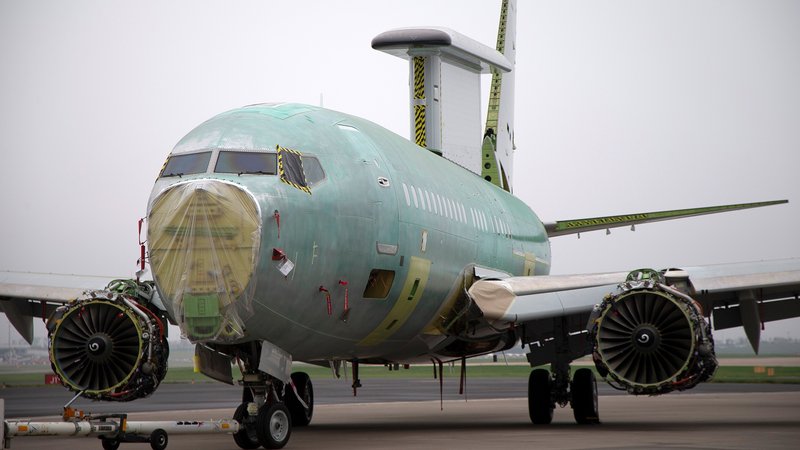Warning signals – is the AEW aircraft market about to take off again?
With the growth of combat aircraft data fusion and management capability, sharing and wider processing of information across the battlespace is a given. Despite this, the dedicated airborne early warning and control (AEW&C) aircraft remains a core asset for many major forces.
Advances in onboard sensors, the advent of AI as a virtual crewmember, the vast flow of information from ground, air and space-based assets and planning for single-seaters to manage UCAV formations are all in progress, but the AEW aircraft seems to have retained its place... Continues below
Newsletter Sponsor:

Above: NATO and USAF E-3s have only received modest upgrades and are now ripe for replacement with the E-7. (Photo: USAF)
Views on big data management and the role of AI have seemingly veered back towards this requiring more than a single pilot, despite the dawning of a new generation of UCAVs. Contemporary market trends indicate that the airborne commander is still considered vital, and to paraphrase a recent film, traditional AEW might be headed for extinction, but not today.
That dedicated AEW aircraft had been falling out of favour was suggested by the leisurely upgrade life of the NATO E-3 Sentry fleet. Not only are airframes reaching the end of their allocated hours, but crucial radar and onboard systems have not kept pace with those of the combat aircraft over which they exercise control.
Even with only modest upgrades, the latest Block 40/45 E-3s will remain in US and NATO service for the medium term, but are about to be eclipsed by a new generation of airliner-based AEW in the form of the Boeing E-7.
The RAAF’s generally positive experience as Wedgetail launch customer and useful role as guinea-pig operator convinced the UK, Turkey and South Korea, followed by the inevitable USAF selection of the Boeing product, which is due to enter service there possibly from 2027 although delays seem inevitable. A final fleet of 26 is sought by the mid-2030s.
Potentially more open to alternative replacements was the jointly operated NATO E-3 fleet, with Saab’s GlobalEye product – procured by the UAE to the tune of five examples – being regarded as a strong technical challenger.

However, an American offering always had the upper hand and thus six E-7s are booked to replace the 14 European E-3s. GlobalEye was also offered as part of a package with Gripen for Finland, but was not enough to offset the momentum of F-35.
Despite this disappointment, both Saab and Boeing have reasons for optimism. A slumbering desire for new, effective multi-environment coordination has recently awoken and opportunities for collaboration and sales are accelerating.
The wave is being driven by an acknowledgement of increased battlefield complexity, the necessity of human input and a new generation of crewed and uncrewed platforms that require management. Furthermore, although costly, available AEW aircraft use proven civil airframes with generous depth of spares and support.
So, who are the candidates and the customers and what unique selling points versus market success factors can be identified? Beyond the iconic E-3 and the smaller carrier-capable E-2 Hawkeye (the future of which is likely limited), several alternatives did exist and achieved significant sales.
The platform with most in common with the E-3 was the Boeing E-767 for Japan, a unique design driven by ending of the 707 line. Given its matching capabilities, it seems surprising that it did not see greater interest, but the security situation of the 1990s was not conductive to new investment in what was seen as a niche capability, especially while existing E-3 fleets were still relatively young.
In contrast, the smaller E-2 saw a number of successes, with a conservative airframe and lower costs, at the expense of diminished performance, making it a fit for more limited roles. The Embraer R-99, based on the ERJ-145 regional airliner, was also directed at smaller operators and remains in limited service as a cost-effective means of managing airspace and coordinating capabilities.
But the greatest success story was Saab’s 340 and 2000-series turboprop aircraft. These perhaps point at what may be a renaissance in the small/medium AEW market. At their height, the types were operated by ten different air arms and offered useful range and capability with acceptable cost.
Saab’s GlobalEye adopts a similar philosophy but combines it with a new gallium nitride-based radar for air and ground work, plus a Leonardo SeaSpray 7500E AESA maritime search radar for operations over water.

Above: GlobalEye’s maritime search radar capability makes it a useful option for air forces wanting full multi-domain force control. (Photo: Saab)
Ukraine and the current Middle East situation have highlighted that multi-domain force control is arguably a more important budget expenditure than a few more fighters or UCAVs. The GlobalEye – as selected by the (traditionally US-tending) UAE – should be a strong contender for this duty.
Meanwhile, Russia and increasingly China’s fielding of such aircraft, albeit in the former’s case relatively old, have raised alarms amongst nations along their borders. As a consequence this has further stoked interest in affordable but capable AEW options.
Business jet-based platforms such as GlobalEye offer speed and altitude, if possibly not the range of the E-7. Both have their selling points as conflicts switch away from Fulda Gap-style scenarios towards more complex environments. One difference might be the queue for the new Boeing product, similar to the circumstances that drove Japan to the E-767. Pacific operations will also suit the GlobalEye-SeaSpray combination.
Saab, despite its legacy and the air-land-sea capability of its newest offering, has several challengers. Offering similar capabilities, although not a maritime radar, the Israeli Oron/Conformal Airborne Early Warning (CAEW) product based on the Gulfstream 550 and featuring two ELW-2085 AESA radars is offered for export, and Italy has already snapped up a pair.
Oron’s exact capabilities are unclear but given Israeli requirements these are likely to be high-end. As with the Saab aircraft, its kinetic abilities favour more altitude and high cruise over absolute range, although these are endlessly variable figures.
The market for such aircraft is certainly growing. Embraer R-99 and older Saab operators are considering replacements, while South Korea has long had a supplemental requirement, and a domestic programme may be in the works, but Boeing seems confident of a repeat win here.
Regional neighbours, also concerned about China, will be watching carefully. Following the UAE, and with Saudi Arabia’s older E-3s becoming antiquated, the Middle East is further fertile ground. Some South American states might consider such a capability, while Canada has begun a programme for AEW after a 50-year lapse, though despite a strong Saab challenge the E-7 has the political high ground.
An interesting outlier here is France. Alongside the UK, it retained a domestic E-3 capability outside the NATO fleet. With the RAF having opted for the US solution and rocky Franco-German defence collaboration this is possibly a Saab open goal – arguably more so should global opinion turn against the Israeli military-industrial complex.
An E-7 might be the obvious solution but this goes against the traditional French view of sovereign capability. An Airbus-based Wedgetail lookalike has been floated, but even by French standards there is a long road to domestic provision.

Above: The E-7 appears to be winning the order battle for new AEW platforms, but it may be too expensive and complex for some operators requiring such a capability. (Photo: UK MoD Crown Copyright)
AEW is becoming an increasingly interesting market area. Its utility arguably has grown and will continue to feature heavily as air-land-sea-space-cyber become more linked and task management more important.
The single-seater fighter or multi-role UCAV wingman still has a bright future, but within a complex sensor-shooter chain (even more so with the rise of non-kinetic effectors), a helping human hand is welcome.
Demand exists, and the US-backed E-7 is enjoying initial success, but alternatives are on the table and in an increasingly multi-polar supply scenario their potential will likely grow. If this were the world of fund management, it would likely be regarded as a strong investment pitch.
Other articles in this newsletter:
Rethinking support fleets – does the US need to change direction on tankers and transports?
Staying power – why mid-life upgrades still matter
Don't want to miss out on future Decisive Edge content? Make sure you are signed up to our email newsletters.











